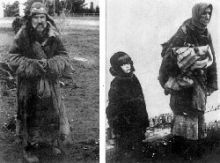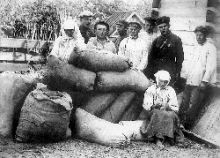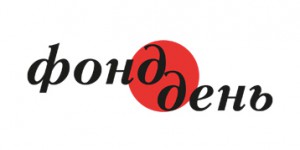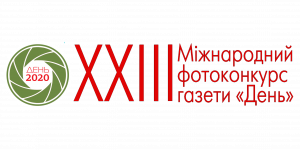Violence is always preceded by massive lies or a cynical concealment of truth. Stalin’s regime desperately tried to hide its atrocities from the rest of the world — primarily the artificial famine in Ukraine, known as Holodomor, in the 1930s. The Day honors the 70th anniversary of Holodomor (which is still not known in the world) by continuous research of this genocide against the Ukrainian people. It swept across the land like a bloody wave, causing every family to suffer. Our piece today is written by Fedir Shepel from Kirovohrad. Having researched some archival data, he tries to answer a simple yet crucial question: “Why did most people who lived in the 30s and knew the truth about the famine choose to remain silent? The truth about Holodomor was first revealed by foreign research. All Soviet historical sources only vaguely referred to it as a time of “certain hardships in rural areas ... ”
A frank answer to this question is f ound in the secret archives of the regional GPU [State Political Administration] and NKVD departments. Some of these documents had until recently been stored at the SBU department of Kirovohrad oblast. After the rehabilitation of the victims of persecutions, the documents have been transferred to open archives. The records prove that not everyone was silent in the face of starvation, but anyone trying to voice a protest was immediately arrested and charged with “criminal anti-Soviet agitation and counterrevolutionary sabotage...”
Most of them — like Venedykt Ripa from Chervony Yar kolhosp — were ordinary, uneducated, non-party peasants. They were wanted by GPU for their resistance when authorities were taking away their grain and dooming them to starvation. Yakiv Bondarenko, a poor peasant from “5 in 4” kolhosp (Five- year Plan in Four Years — Ed. ) had no statesman’s talent, yet he accurately assessed the situation, “If we try to meet the states bread requirements, we will starve.” He was 34 years old when he was arrested in Dobrovelychkovka (currently a district center of Kirovohrad oblast) and sent to the penitentiary of Zinovyevsk (the name of Kirovohrad in 1924-34 — Ed. ), where he died on April 10, 1933.
The inmates also suffered from lack of food that spring. Several archival cases on peasants resisting state agrarian policy contain interesting statements, such as this one: “No one appeared at the court hearings. Enclosed with the case is a medical certificate confirming the defendant’s death. The court, therefore, ruled the case finally closed.” The defendant was Vasyl Ivaniv of Vilshany district who testified that anticipating a great famine, he and his father had tried to hide some of their grain. Vasyl died in prison in April 1933. Another peasant, Zinko Karasuh from Free Labor kolhosp, was arrested by GPU in Znamensky district and died in prison on March 25, 1933. Though Zinko had received only elementary education, he was able to draw an accurate historical analogy: “The kolhosps are a new kind of serfdom.”
Records of the Nova Ukrainka district GPU station state that Maksym Babiychuk from The Third and Decisive [kolhosp] “conducted systematic campaigns against grain collection, saying that kolkhozes should care about their people first, and then supply grain to the state...” He also said that the state plan could not be fulfilled, because the grain harvest was too small that year and the state demands too big. “If we kept our grain, we would not have to beg for food. The Soviets would beg us.”
In May 1933, Zinovyevsk city GPU department investigated a case involving Borys Buhry. The man was arrested for saying to his fellow collective farmers, “What we have is not a political power but a gang. They starve people to death by taking away all their grain... They make us work and give us no food.”
Not only peasants were enraged by hunger. Workers took the stand too. Anton Tkachuk, father of seven children, employee of the Svirnivsky sugar refinery, attracted GPU’s attention by “systematically inciting workers to go on strikes because of reduced bread rations.” He predicted that they would “starve to death in the spring. If they are cutting down on bread in the winter, by springtime there will be no bread at all.” He also said that “they are taking away seed grain; it means that we’ll have a real famine.”
Word of famine spread to other parts of the vast Soviet Union where Ukrainians lived. April 6, 1933, Oleksiy Ihnatenko of Makhachkala was arrested at the railway station of Znamenka for “spreading slanderous allegations that people [living in the vicinity of the river] Kuban slaughter horses in return for bread, that there are cases of cannibalism, and that starving people eat cats and dogs.”
The manmade famine seriously affected the peasant’s psyche and even traditional religious-ethic views. Before that no one in Ukraine could have talked spitefully of anyone’s death. The horrible attitude of the authorities to ordinary people changed that old mindset. Ulianovsky GPU district station had it on record that a peasant woman by name of Maria Tymoshenko said, during a meeting of mourning after the assassination of Kirov that “Some may feel sorry about Kirov getting killed, but I wish a dozen like him went the same way. Maybe our life would be a little better then. Why do they talk so much about him? Hundreds died in our village in the spring of 1933, and there was not a word about them in the papers.” She was rehabilitated only in 1992, after Ukraine had declared independence. Maria’s case was reviewed, and the justice system acknowledged the scope of tragedy experienced by that woman, wife of a “dispossessed kulak.”
Even a few years after the famine it remained dangerous to remember the “Red terror”. On April 6, 1937, the Nova Heorhyevka district NKVD station arrested Oleksandr Reshylov, 44-year-old grade school principal at the village of Velyka Skeleva. The man was charged with “counterrevolutionary agitation” among colleagues. He had unfortunately recalled 1933. During an interrogation on May 11 he testified, “I told colleagues that Comrades Molotov and Kosior visited Kirovo (Kirovohrad in 1934-39 — F.Sh. ) in 1933. Both knew there were cases of death of starvation, yet they demanded that the grain quotas be fulfilled... At the time even some party members said that there was no grain left in Kirov district, so Comrade Molotov ordered them expelled from the party.” Reshylov tried to prove that the regime had been well aware of the situation and acted purposefully.
This case also contained some transcripts of interrogation of 6-7 grade students, signed by interrogation officers, prosecutors, and schoolteachers. One of the latter wrote, in particular, “I hereby testify that there have been no threats or intimidation. The children were not nervous and answered the questions freely.” Reshylov did not admit to any “counterrevolutionary agitation” during the investigation and court hearings, trying to explain that his words “it was bad in 1933, there was no bread and people died...” were misinterpreted. He was found guilty and sent to a corrective labor lamp.
If someone was drafted into the Red Army even years later, he had to keep silent about his experience in the early 30s. If he said anything, he was subject to repression. Here is a transcript of interrogation dated 1940. The subject, Trokhym Matiyevsky, Red Army recruit, born in the village of Moshchene, Haivoronivka district, was persecuted for the following words:
“Question: Have you witnessed people eat cats and dogs, and humans being buried alive?”
“Answer: There was a severe famine in our district. It is a fact. I remember that I had nothing to eat for three or four days at a time. I could barely stand on my feet. It is also true that people died of starvation. I heard the rest from eyewitnesses...”
Incriminating evidence against Musiy Lyzhnenko, a 24-year-old soldier, born in the village of Ivankivtsi, Nova Heorhiyevka district, persecuted in 1935, in Gorky oblast, included “malicious hearsay about a famine allegedly experienced by his fellow villagers in 1933.”
There is evidence of soldiers fighting in the Soviet-Finnish war telling the truth about the Holodomor. One of them, Yakiv Andriyenko, born in Znamenka district, was drafted in the Red Army on September 7, 1939, at the age of 20. On January 3, 1940, he was a part of a unit reinforcing the 18th Infantry Division which was surrounded in the vicinity of Pitkyaranta. After a 15 km ski march, their company was spotted by the Finns. Yakiv was wounded and taken prisoner of war. After the war he was accused of spreading anti-Soviet slander at the POW camp, saying that children were no longer baptized at home, that the new regime was closing churches, although icons could still be found in some homes, and that there was a famine in 1933 and a lot of people died a horrible death.
So, many Ukrainians refused to keep silent about the Holodomor. These stories of famine survivors speak volumes. Yet Stalin’s regime made it taboo to speak about the horrors of the Ukrainian famine, and Soviet law enforcement agencies did everything in their power to put it in force.








